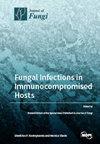Rad6 通过影响 Beauveria bassiana 的生物素代谢调控萌发
IF 4.2
2区 生物学
Q2 MICROBIOLOGY
引用次数: 0
摘要
Rad6 是一种典型的泛素连接酶,因其在酵母中调控染色体相关细胞过程的作用而闻名,已被证实在 Beauveria bassiana 中具有多种功能,包括昆虫致病生活方式、紫外线损伤修复和分生孢子。然而,以往的研究只报道了 Rad6 在富营养培养基中调控分生孢子产生的关键作用,而没有对其机理进行深入分析。在这项研究中,我们发现无论真菌是在营养丰富还是营养匮乏的环境中培养,Rad6 的缺失都会导致分生孢子产量的显著减少。Rad6 的缺失会抑制中央发育途径中的重要基因(即 brlA、abaA 和 wetA)的转录,从而直接导致分生孢子能力的下降。此外,突变株在营养丰富的条件下培养时,分生孢子的产生和头状花序的发育都出现了更明显的下降。这一观察结果与富营养化培养条件下中央发育途径(CDP)下游基因 vosA 的下调和 flaA 的上调有关。此外,单转录组学分析表明,生物素代谢、DNA 修复和色氨酸代谢的不规则性是导致分生孢子产量降低的潜在因素。综合双转录组学分析指出,生物素代谢异常是导致分生孢子产量下降的主要原因。随后,我们通过补充生物素成功恢复了 Rad6 突变株的分生孢子产量,进一步证实了转录组学证据。总之,我们的研究结果强调了 Rad6 在影响生物素代谢、进而影响 CDP 基因表达并最终影响 B. bassiana 无性生命周期中的关键作用。本文章由计算机程序翻译,如有差异,请以英文原文为准。
Rad6 Regulates Conidiation by Affecting the Biotin Metabolism in Beauveria bassiana
Rad6 is a canonical ubiquitin-conjugating enzyme known for its role in regulating chromosome-related cellular processes in yeast and has been proven to have multiple functions in Beauveria bassiana, including insect-pathogenic lifestyle, UV damage repair, and conidiation. However, previous studies have only reported the key role of Rad6 in regulating conidial production in a nutrient-rich medium, without any deep mechanism analyses. In this study, we found that the disruption of Rad6 leads to a profound reduction in conidial production, irrespective of whether the fungus is cultivated in nutrient-rich or nutrient-poor environments. The absence of rad6 exerts a suppressive effect on the transcription of essential genes in the central developmental pathway, namely, brlA, abaA, and wetA, resulting in a direct downregulation of conidiation capacity. Additionally, mutant strains exhibited a more pronounced decline in both conidial generation and hyphal development when cultured in nutrient-rich conditions. This observation correlates with the downregulation of the central developmental pathway (CDP) downstream gene vosA and the upregulation of flaA in nutrient-rich cultures. Moreover, single-transcriptomics analyses indicated that irregularities in biotin metabolism, DNA repair, and tryptophan metabolism are the underlying factors contributing to the reduced conidial production. Comprehensive dual transcriptomics analyses pinpointed abnormal biotin metabolism as the primary cause of conidial production decline. Subsequently, we successfully restored conidial production in the Rad6 mutant strain through the supplementation of biotin, further confirming the transcriptomic evidence. Altogether, our findings underscore the pivotal role of Rad6 in influencing biotin metabolism, subsequently impacting the expression of CDP genes and ultimately shaping the asexual life cycle of B. bassiana.
求助全文
通过发布文献求助,成功后即可免费获取论文全文。
去求助
来源期刊

Journal of Fungi
Medicine-Microbiology (medical)
CiteScore
6.70
自引率
14.90%
发文量
1151
审稿时长
11 weeks
期刊介绍:
Journal of Fungi (ISSN 2309-608X) is an international, peer-reviewed scientific open access journal that provides an advanced forum for studies related to pathogenic fungi, fungal biology, and all other aspects of fungal research. The journal publishes reviews, regular research papers, and communications in quarterly issues. Our aim is to encourage scientists to publish their experimental and theoretical results in as much detail as possible. Therefore, there is no restriction on paper length. Full experimental details must be provided so that the results can be reproduced.
 求助内容:
求助内容: 应助结果提醒方式:
应助结果提醒方式:


